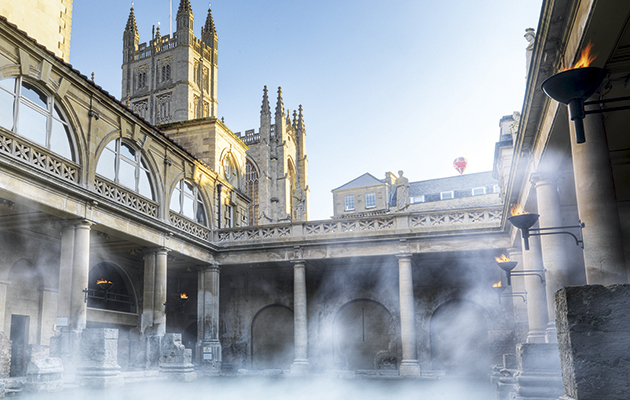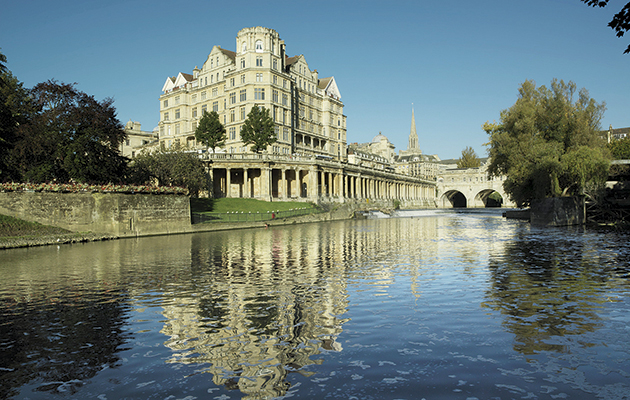The renaissance of Bath
We all know how beautiful Bath is, but the city is finally living up to its potential with a host of new openings


A Roman city, a Georgian city or an early-Victorian reinvention? Bath is all of these and more. as the art historian James mcDonaugh observed: ‘Bath has been in the renaissance business for a long time.’ and now it’s doing it again. after a period in the westerly doldrums, this architectural gem is on the cusp of achieving permanent status as a world-class cultural destination. The reason? a synergy of happy circumstances converging upon this valley on the River avon.
July witnessed the opening, right in the Georgian city centre, of the first grand hotel by a major international resort operator; another major hotel launch is due next year, as is electrification of the Great Western Railway. The latter will reduce journey times from Londontoaboutanhour.
In anticipation, festivals celebrating literature, regional food and fashion are burgeoning, with the aim of restoring Bath to its position of social magnet as orchestrated by Beau Nash and chronicled by Jane austen. The appointment earlier this year of a dynamic new director of tourism in the shape of David James, architect of the Peak District’s resurgence, demonstrates the city fathers’ determination to leverage the investment flowing in.

The Bath of my childhood memory was dark, damp and rundown, more redolent of Gothic fantasy than the Georgian exuberance celebrated in Persuasion. Forty years on, the transformation is startling: the exquisite circuses, crescents and squares have emerged from sooty gloom to reclaim their original honey-coloured majesty.
None more so than John Wood the Younger’s majestic Royal Crescent, built overlooking Victoria Park between 1767 and 1774, which so reminded Jan morris of Versailles. admiring the Ionic columns of Bath stone rusticated at the ground floor, I cast about for a sign indicating the eponymous hotel. Such is its owner’s discretion and such.
Since its opening in 1973, the Royal Crescent Hotel has served as a barometer of the city’s fortunes. Now, the forecast is favourable, as a major investment by the new private owners has achieved ultra-luxury status minus the usual bling. after sympathetic restoration of the 45 guest rooms and suites, the hotel offers as close to the experience austen’s elevated Lady Dalrymple might have enjoyed as modern tastes allow. That is to say authentic period furniture and pictures, but modern bathrooms.
and if bathing is not the point of being in Bath, what is? That said, high society, at least as described in Northanger Abbey, seems to have done more partying than bathing. That hasn’t prevented the installation in the old coach house of a handsome spa run‘byESPa-trainedtherapists.
Exquisite houses, the beauty of Nature, and how to get the most from your life, straight to your inbox.
If bathing is not one does not need to be especially affluent to enjoy the hotel, following the introduction this spring of sumptuous but reasonably priced teas happily devoid of denture- challenging Bath buns. The arrival of David Campbell, formerly chef to the England rugby team, at the hotel’s Dower House Restaurant has enhanced the city’s culinary ascent. ‘Generally, the higher the altitude, the better one eats,’ remarks a local friend.
michelin has already saluted Sam moody’s cooking at the Bath Priory Hotel up on Weston Hill. This is fitting, for restaurant historian Gerard Noel traces the birth of modern anglo-French cooking to the legendary Hole in the Wall opened by George Perry-Smith on George Street in 1952. Today, it is the site of the engaging Clayton’s Kitchen at the Porter, with handsome serviced apartments available on short lets immediately above.
To Bath’s great glories of the Roman Baths, the medieval abbey, the Pump Room, the assembly Rooms and adam’s Pulteney Bridge (pictured above) have been added attractions new. Next to the classical Cross Bath, more Palladian temple than caldarium, shimmers the modern Thermae spa. Opposite is the former Royal United Hospital, now the Gainsborough Bath Spa.
The hotel offers 99 deluxe guest rooms and suites and the only natural thermal spa in the UK, with water pumped in from the same aquifer that supplies the Roman Baths. At £25 million (and counting), it’s the size of investment other destinations might flaunt some discreet environmental flexibility to attract. Not Bath. The Gainsborough opened more than a year behind schedule, a delay attributed by resi- dents to local conservation authorities determined to preserve the city’s status as a UNESCO World Heritage Site.

‘Essentially, the clock has been stopped and no changes to exteriors or even the interiors of listed buildings, which is to say almost all of the centre, are permitted,’ says a local business owner. The argument now is about the date at which that clock has been frozen. For although Georgian Bath was largely the work of three men and erected in just 30 years in the middle of the 18th century, much, including the 1820s vintage Royal United Hospital, has been remodelled since, often improving on original speculative construction.
Two barely visible marks on the rear elevation of the Royal Crescent Hotel set general manager Jonathan Stapleton off on a hunt for the original plans. These disclosed the presence of a conservatory, consent for the reconstruction of which has recently been granted.
By comparison, the inclusive programme of events at the museums and galleries is positively radical, the Holburne Museum of Art leading with a curriculum that includes the exhibition ‘Canaletto Celebrating Britain’ (until October 4). One senses a rise to the challenge posed by evolution from past complacency to cosmopolitan future. But then, Bath is no longer the uninspired backwater it was during the period of architectural vandalism in the 1960s and 1970s.
From a vantage point over the Royal Crescent, the contrast between the sublime integrity of the façade and the eccentric variation of the rear is singular: the 30 houses are quite dissimilar, built by different architects, with an oriel projecting here and a Georgian lean-to slumping there. It is this tension between external perfection and interior variation that makes Bath and its citizenry what it is.
We are sorry to record that Julian Allason died unexpectedly not long after submitting this article
Find out more
Bath Information http://visitbath.co.uk
Royal Crescent Hotel 01225 823333; www.royalcrescent.co.uk
Gainsborough Bath Spa 01225 358888; www.thegainsboroughbathspa.co.uk
Bath Priory Hotel 01225 331922; www.thebathpriory.co.uk
Country Life is unlike any other magazine: the only glossy weekly on the newsstand and the only magazine that has been guest-edited by His Majesty The King not once, but twice. It is a celebration of modern rural life and all its diverse joys and pleasures — that was first published in Queen Victoria's Diamond Jubilee year. Our eclectic mixture of witty and informative content — from the most up-to-date property news and commentary and a coveted glimpse inside some of the UK's best houses and gardens, to gardening, the arts and interior design, written by experts in their field — still cannot be found in print or online, anywhere else.
